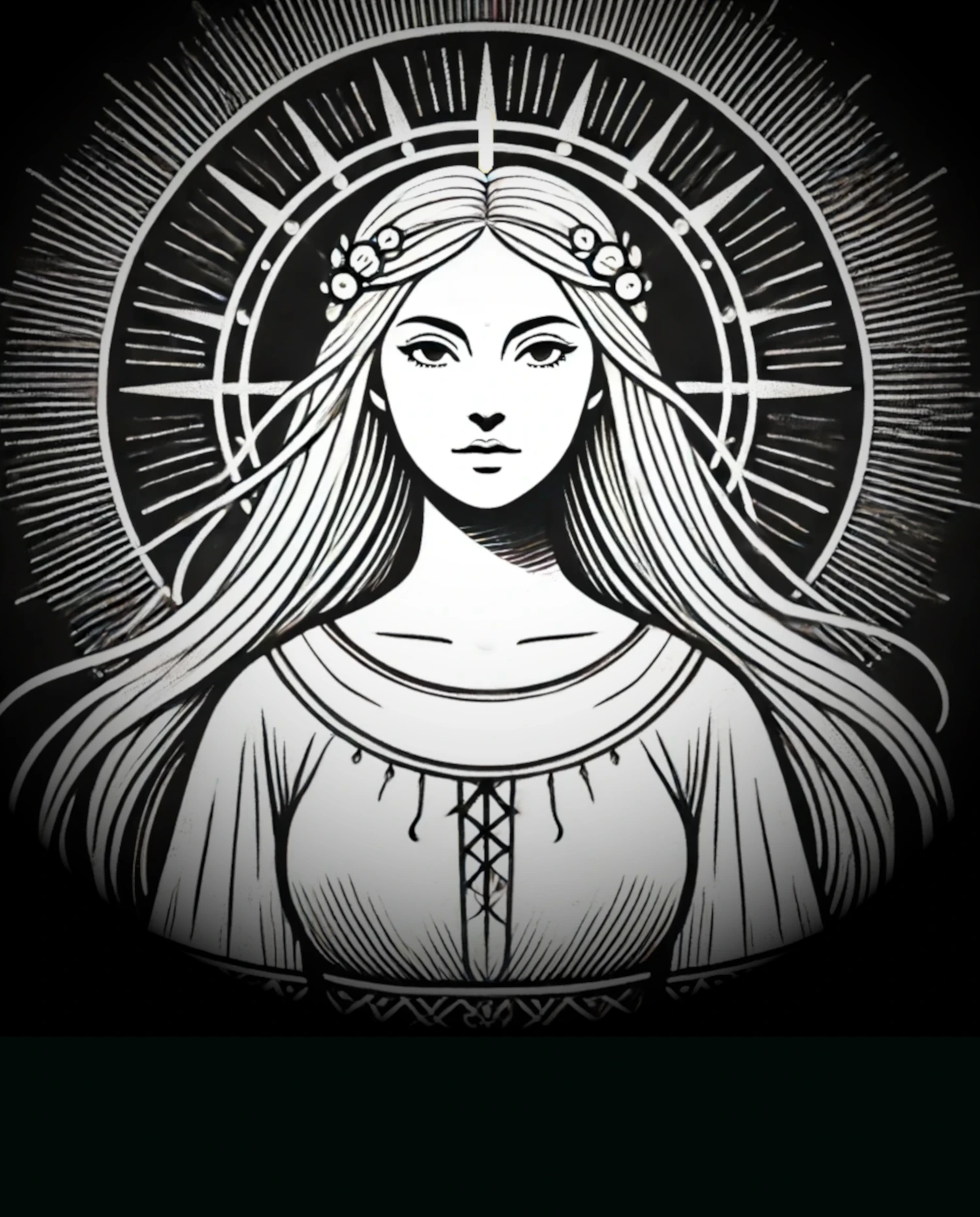
| Alternate Names: | Sunna, Sól |
| Iconography: | Sun, the Sun Wheel, A Chariot Wheel |
| Domains: | Time, Life, Beauty, Growth |
Table of Contents
Historical Attestations
Sunne, also spelled Sunna in Old High German, or Sól in Old Norse, is the personified figure of the sun in Anglo-Saxon pagan mythology. She is known as the ruler of the day and is said to govern the cycles of the sun. This association with timekeeping is also supported by Bede in De Temporum Ratione, where Sunne is described as the “measurer of days.” As the ruler of the day, Sunne was likely seen as a powerful and vital force in the natural world, responsible for providing warmth and light to the earth. This association with light and warmth is evident in many Old English texts, where she is described as “shining” and “bright.” Sunne was also likely associated with life and growth, as she was responsible for providing the energy necessary for plants and animals to thrive.
In Norse mythology, Sól (also known as Sunna) is a prominent figure as the personification of the sun. She is depicted as a goddess who drives the chariot of the sun across the sky.
The Merseberg Charms
The Merseburg Charms are two medieval magic spells written in Old High German, discovered in 1841 by Georg Waitz in a theological manuscript from the abbey of Fulda. They are the only known examples of pre-Christian, Germanic pagan incantations written in the Germanic language, providing a rare glimpse into early Germanic mythology and magical practices. The fist is beyond the scope of this entry, but the second is of interest:
Phol ende Wodan vuoron zi holza. du wart demo Balderes volon sin vuoz birenkit. thu biguol en Sinthgunt, Sunna era suister; thu biguol en Friia, Volla era suister; thu biguol en Wodan, so he wola conda: sose benrenki, sose bluotrenki, sose lidirenki: ben zi bena, bluot zi bluoda, lid zi geliden, sose gelimida sin.
“Phol and Wodan rode into the forest. Then Balder’s foal sprained its foot. Then Sinthgunt, Sunna her sister, conjured it; Then Friia, Volla her sister, conjured it; Then Wodan conjured it, as he well could: Like bone-sprain, so blood-sprain, so joint-sprain: Bone to bone, blood to blood, joints to joints, so may they be glued.”
The second charm mentions Sunna (Sól in Norse mythology), the personification of the sun, highlighting her divine status alongside other deities like Wodan (Woden) and Balder. While some scholars seem to have dismissed this point, it would seem to this author to indisputably place Sunna alongside deities such as Friia and Wodan, as a being of like status, a goddess personifying the sun, as is common in other Indo-European cultures, including that of Early Medieval Scandinavia.
Norse Mythology: Poetic and Prose Edda
The Poetic Edda and Prose Edda offer vivid depictions of Sól. In these texts, she drives the chariot of the sun across the sky, underscoring her divine importance. The Prose Edda, authored by Snorri Sturluson, details Sól’s relentless journey pursued by the wolf Sköll, illustrating her critical role in the cosmic order. Snorri provides a number of kennings1Snorri Sturluson, and Anthony Faulkes. Edda: Skáldskaparmál. Viking Society for Northern Research : University College London, 1998. for the Sun in Skáldskaparmál, such as “sister of Máni”, “wife of Glen”, “fire of sky and air” and then cites a verse by the skald, Skúli Þórsteinsson, highlighting her celestial journey and divine nature:
God-blithe bedfellow of Glen steps to her divine sanctuary with brightness; then descends the good light of grey-clad moon.
Centrality of the Sun in Early Germanic Life
Bronze Age petroglyphs in Scandinavia, such as those in Bohuslän and Tanum, depict sun symbols and scenes involving the sun, highlighting its possible centrality in early Germanic spiritual life. These carvings often show sun wheels and chariots, which align with later Norse myths of Sól’s sun chariot. The recurring sun motifs in these petroglyphs demonstrate the importance of the sun in daily life and its revered status in early Germanic societies.
Conclusion
The consistent depiction of Sunne/Sól in Anglo-Saxon and Norse mythology, supported by linguistic connections to other Indo-European solar deities, emphasizes her significance as a solar goddess. The “Merseburg Charms”, Poetic Edda, and Prose Edda all highlight her divine role, while archaeological evidence from Bronze Age petroglyphs underlines the centrality of sun worship in early Germanic life.
This synthesis of textual and archaeological evidence affirms Sunne’s importance in Germanic mythology, illustrating a shared cultural reverence for the sun across Indo-European traditions.
Ingwine Guidance
Sunne is the personified Sun, a goddess who brings life-giving warmth, light, and who along with her brother Mona, measures the passage of time.
